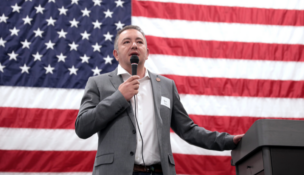Budget Plan B may not exist, or it may mean ‘K-12, beware’
Luige del Puerto//January 23, 2011//[read_meter]
Budget Plan B may not exist, or it may mean ‘K-12, beware’
Luige del Puerto//January 23, 2011//[read_meter]

Last year, Gov. Jan Brewer and the Republican-led Legislature adopted a budget plan that relied on revenues that never materialized.
This year, the governor is proposing Medicaid cuts that the federal government may disapprove or worse, state courts may strike down as illegal.
But here’s what binds the two budgets: There appears to be no Plan B.
That means if the proposal to drop 280,000 people from Arizona Health Care Cost Containment System is waylaid, the governor and lawmakers would have to scramble to plug a $542 million deficit months after this year’s session has ended.
It’s possible the final budget that is enacted will contain a contingency provision, which would spell out the spending cuts or other solutions to be triggered if the waiver request were denied.
At that point, the governor could also call for a special session or wait for next year before fixing the shortfall.
Asking the Legislature to convene in a special session will be the easy part. The big question is: How will lawmakers solve that kind of a budget hole?
Paul Senseman, the governor’s spokesman, won’t speculate what kinds of solutions will be proposed if the plan goes awry. But he warned of “potentially devastating” consequences if the federal government denies the waiver request or a court throws out the proposed Medicaid cuts.
“There’s likely to be devastating consequences to the rest of state spending if either one of those scenarios play out,” Senseman said.
Senate President Russell Pearce put it more starkly.
“How can you have an option when you really don’t have any?” Pearce said, reiterating that the state has no money and is on the brink of bankruptcy.
Brewer hasn’t yet drawn up a contingency plan if her waiver request goes nowhere, but Pearce can foresee what’s coming: “That means we’re going to cut some place, and if it’s not Medicaid, then it’s K-12. It’s higher education… And this (AHCCCS rollback) is the easiest cut because it brings us in line with the other states.”
That’s why even if the president of the state’s biggest teachers union applauded Brewer’s efforts to minimize cuts to K-12 education, particularly when compared with what happened to other programs, the uncertainty gives him reason to pause.
“There is no certainty in this budget for education, and there is very little comfort to be found in it,” said Andrew Morrill, head of the Arizona Education Association.
No one is recommending cutting the K-12 education budget by $542 million if funding for AHCCCS can’t be touched. But Morrill has good reasons to be concerned.
Education, health and corrections make up 87 percent of ongoing state spending. Of the three, the K-12 budget has the biggest share, and the federal government no longer requires Arizona to maintain education spending at the 2006 level.
Sen. Steve Gallardo, a Democrat from Phoenix, said Brewer’s plan ultimately endangers K-12 education.
If the waiver request is denied, Gallardo said, Brewer will call the Legislature into a special session to cut spending.
“She knows deep down in her heart that the federal government is not going to approve this,” he said. “So she wants to be able to turn around and tell the voters, ‘We tried. We asked the federal government for assistance. They told us no. Obama told us no. So now, because of what Obama has told us we have to now cut K-12 education drastically.’
“That’s the ultimate plan. There is no backup plan,” he added.
But Senate Majority Leader Scott Bundgaard said to say there’s no Plan B is “foolish” because lawmakers are working to come up with more solutions.
“This is only one component of a larger plan,” he said. “We’re looking for options to balance the budget right now.”
Besides outright spending cuts, lawmakers could look for ways to make the delivery of services more efficient, which would save money.
But the options that would generate sizable savings or raise significant amounts of money are few and controversial.
An obvious recourse is to borrow more money. Another option is to defer payments of existing debts. Both options will cost Arizona more in the long run.
The state government could again defer payment to school districts.
Also, the state can raise taxes, which is unlikely.
Meanwhile, Democrats are proposing to suspend existing tax credits. But in the past, Republicans have shot down the idea.
Some Republicans candidly admitted that Plan B is blank.
“We don’t really have an alternative. There is no Plan B. (The Medicaid waiver request) is just something we need to do,” said Sen. Ron Gould, a Lake Havasu City Republican.
If the feds deny the request, Gould said Arizona then can decide “whether we do it anyway.”
Or Arizona could consider whether to “toss Medicaid back in their (federal government’s) lap,” he added.
On Jan. 20, the Legislature promptly complied with Brewer’s request to give her the authority to seek a Medicaid waiver, but the debate over the proposed AHCCCS rollback will linger and likely get sharper in the coming days.
Democrats have been pressing one point: Regardless of the fate of the Medicaid waiver, the AHCCCS cuts must be approved by voters, and a lawsuit is coming if Republicans go ahead without that vote.
Republicans have countered that the language of Prop 204, the 2000 ballot initiative that expanded AHCCCS coverage, allows the state to defund the program without going back to the voters.
They added that Arizona has a good case to make with the federal government. First, Arizona offers medical coverage that is more generous than most states have. Additionally, Arizona’s medical coverage actually exceeds the federal limits.
The proposition states revenues from a tobacco litigation settlement shall be used for the medical coverage expansion and “shall be supplemented, as necessary, by any other available sources including legislative appropriations and federal monies.”
The argument is that the state is in a crisis and therefore has no “available sources” for the program.
Sen. Andy Biggs, the chairman of the Senate Appropriations Committee, said he anticipates a legal challenge, but for him the question is how the state government will demonstrate that it doesn’t have other available sources for the Medicaid program.
“Does it mean you have to raid education, decimate them?” Bigg said. “Does it mean… that you have to raise taxes mightily in order to get the other available funds?”
House Minority Leader Chad Campbell, however, argued that there are available funds. The fact that Brewer’s budget proposal includes increased funding for some agencies, such as the Department of Corrections, negates Republican arguments that there is no money available.
“We can’t say there are no available resources,” said Campbell, a Phoenix Democrat.
Democrats have also added another potential complication for the waiver request: timing.
During the floor debate on Jan. 20, Sen. Kyrsten Sinema, a Phoenix Democrat said it takes about 10 months on the average to negotiate a waiver with the federal government. Even if granted, the waiver would miss the timeframe for the AHCCCS cuts the governor is seeking, making the budget “unrealistic.”
But Biggs said given the state’s fiscal woes, it has to try nonetheless.
“If you think that it’s a long shot, fine,” Biggs said. “But the reality is just because it’s a long shot doesn’t mean you don’t get into the game and try to get that waiver.”

















